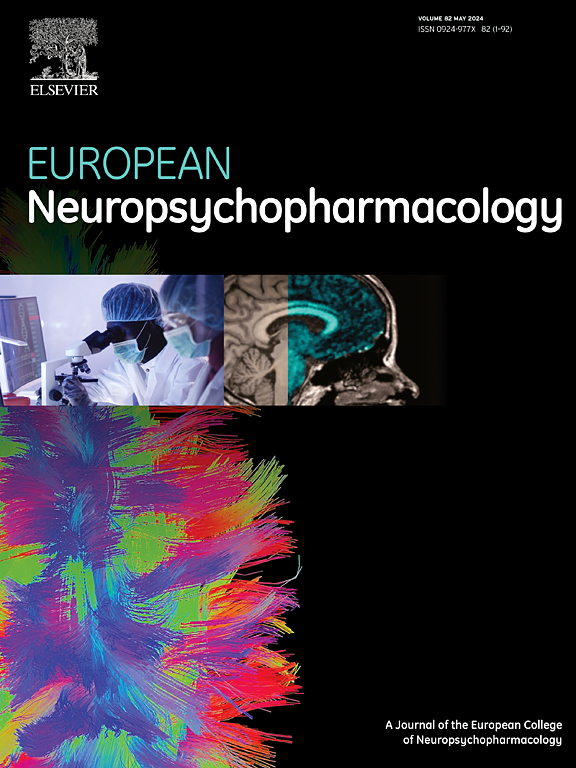LEVERAGING STATISTICAL GENETICS TOOLS FOR CHARTING TRAJECTORIES OF BRAIN DEVELOPMENT AND ITS RELATION TO PSYCHIATRIC DISORDERS
IF 6.7
2区 医学
Q1 CLINICAL NEUROLOGY
引用次数: 0
Abstract
Adolescence is a time of significant structural brain changes, coinciding with the onset of many psychiatric illnesses. It has been hypothesized that deviations in brain maturation during adolescence contribute to the development of psychiatric disorders. Both psychiatric disorders and brain structure are highly heritable; thus, a genetic framework linking these factors may provide additional insights into the etiology of mental health disorders. In this talk, I will present results that apply novel statistical genetics tools to chart the trajectories of brain development and that examine the overlap of associated genetic variants with various psychiatric disorders.
First, I will introduce the Fast and Efficient Mixed-Effects Algorithm (FEMA, Parekh et al., 2024), a novel statistical method for fitting large-scale mixed-effects models in a computationally efficient manner; and its extension FEMA-Long (Parekh et al., forthcoming), specifically optimized for longitudinal phenotypes. FEMA-Long allows for longitudinal GWAS as well as discovery of SNPs that show time-dependent effects. I will present results from the application of FEMA-Long to cortical thickness, surface area, and sulcal depth derived from T1-weighted structural images from the Adolescent Brain Cognitive Development (ABCD) Study (n = 11,511 subjects, 28,898 observations across four time points, mean age at baseline: 9.96 ± 0.62 years, 11,065 subjects; at first follow-up 12.00 ± 0.65 years, 7,735 subjects; at second follow-up 14.16 ± 0.72 years, 6,116 subjects; and at third follow-up 16.09 ± 0.66 years, 3,982 subjects) and show the patterns of changing heritability over the course of brain development and maturation.
In the second part of this talk, I will show results from longitudinal GWAS applied to brain structural features. I will specifically highlight results from the non-linear SNP × time interaction, thereby discovering genetic variants that show time-dependent effects on the development and maturation of the brain during adolescence. In addition, I will highlight the use of another statistical genetics method, MOSTest (van der Meer et al., 2020), that can pool distributed genetic signals across brain regions to boost statistical power, maximizing the potential for discovery of genetic variants associated with dynamically changing brain morphometry in adolescence. Finally, I will present results from the application of pleiotropy informed conditional false discovery rate (Andreasen et al., 2013) on the summary statistics from FEMA-GWAS and MOSTest in the ABCD Study to show how these genetic variants, associated with brain structural changes during adolescence, also overlap with the genetic variants for different psychiatric conditions, with particular emphasis on the genetic overlap with schizophrenia and bipolar disorder.
Overall, this talk will introduce new statistical genetics tools and demonstrate their use in combining longitudinal neuroimaging and genetics data to enhance discovery and provide mechanistic insights about the neurobiology of psychiatric disorders.
利用统计遗传学工具绘制大脑发育轨迹及其与精神疾病的关系
青春期是大脑结构发生重大变化的时期,与许多精神疾病的发病相吻合。据推测,青春期大脑成熟的偏差会导致精神疾病的发展。精神疾病和大脑结构都具有高度遗传性;因此,将这些因素联系起来的遗传框架可能为精神健康障碍的病因学提供额外的见解。在这次演讲中,我将展示应用新的统计遗传学工具来绘制大脑发育轨迹的结果,并检查与各种精神疾病相关的遗传变异的重叠。首先,我将介绍快速高效混合效应算法(FEMA, Parekh等人,2024),这是一种新的统计方法,用于以计算高效的方式拟合大规模混合效应模型;及其延伸FEMA-Long (Parekh等人,即将出版),专门针对纵向表型进行了优化。FEMA-Long允许纵向GWAS以及发现显示时间依赖效应的snp。我将介绍从青少年大脑认知发展(ABCD)研究的t1加权结构图像中提取的FEMA-Long对皮质厚度、表面积和脑槽深度的应用结果(n = 11,511名受试者,四个时间点的28,898次观察,基线时的平均年龄:9.96±0.62岁,11065名受试者,第一次随访时为12.00±0.65岁,7,735名受试者,第二次随访时为14.16±0.72岁,6,116名受试者;在第三次随访(16.09±0.66年,3,982名受试者),并显示在大脑发育和成熟过程中遗传力的变化模式。在这次演讲的第二部分,我将展示纵向GWAS应用于大脑结构特征的结果。我将特别强调非线性SNP × 时间相互作用的结果,从而发现对青春期大脑发育和成熟表现出时间依赖性影响的遗传变异。此外,我将重点介绍另一种统计遗传学方法MOSTest (van der Meer et al., 2020)的使用,该方法可以汇集大脑区域的分布遗传信号,以提高统计能力,最大限度地发现与青春期大脑形态动态变化相关的遗传变异。最后,我将介绍在ABCD研究中FEMA-GWAS和MOSTest的汇总统计数据上应用多向性通知条件错误发现率(Andreasen等人,2013)的结果,以显示这些与青春期大脑结构变化相关的遗传变异如何与不同精神疾病的遗传变异重叠,特别强调与精神分裂症和双相情感障碍的遗传重叠。总的来说,这次演讲将介绍新的统计遗传学工具,并展示它们在结合纵向神经成像和遗传学数据方面的应用,以加强对精神疾病的神经生物学发现和提供机制见解。
本文章由计算机程序翻译,如有差异,请以英文原文为准。
求助全文
约1分钟内获得全文
求助全文
来源期刊

European Neuropsychopharmacology
医学-精神病学
CiteScore
10.30
自引率
5.40%
发文量
730
审稿时长
41 days
期刊介绍:
European Neuropsychopharmacology is the official publication of the European College of Neuropsychopharmacology (ECNP). In accordance with the mission of the College, the journal focuses on clinical and basic science contributions that advance our understanding of brain function and human behaviour and enable translation into improved treatments and enhanced public health impact in psychiatry. Recent years have been characterized by exciting advances in basic knowledge and available experimental techniques in neuroscience and genomics. However, clinical translation of these findings has not been as rapid. The journal aims to narrow this gap by promoting findings that are expected to have a major impact on both our understanding of the biological bases of mental disorders and the development and improvement of treatments, ideally paving the way for prevention and recovery.
 求助内容:
求助内容: 应助结果提醒方式:
应助结果提醒方式:


